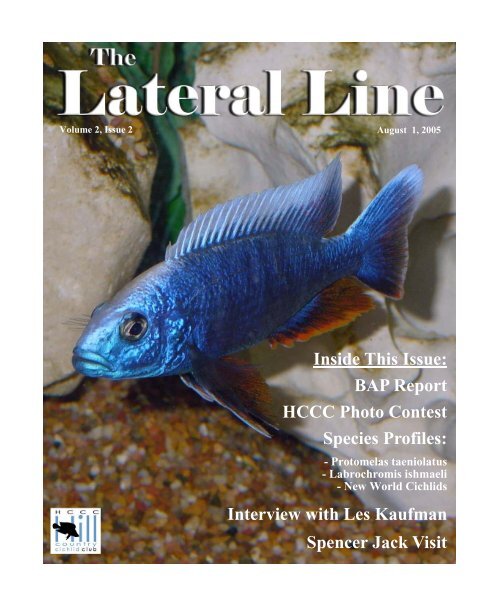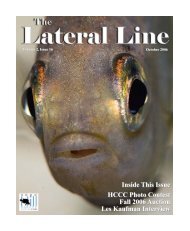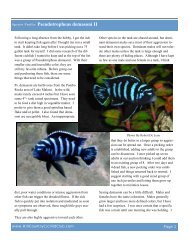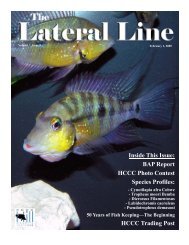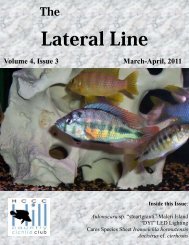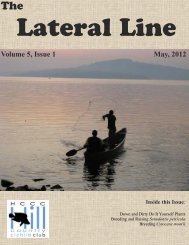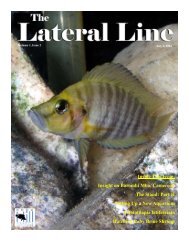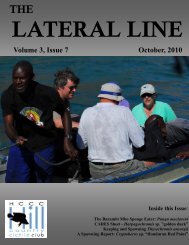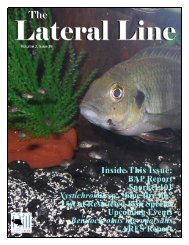Lateral Line August 2005.pub - Hill Country Cichlid Club
Lateral Line August 2005.pub - Hill Country Cichlid Club
Lateral Line August 2005.pub - Hill Country Cichlid Club
Create successful ePaper yourself
Turn your PDF publications into a flip-book with our unique Google optimized e-Paper software.
Volume 2, Issue 2 <strong>August</strong> 1, 2005Inside This Issue:BAP ReportHCCC Photo ContestSpecies Profiles:- Protomelas taeniolatus- Labrochromis ishmaeli- New World <strong>Cichlid</strong>sInterview with Les KaufmanSpencer Jack Visit
The <strong>Lateral</strong> <strong>Line</strong> Page 2<strong>August</strong> 1, 2005INSIDE THISISSUE:Photo Contest 3Les Kaufman Interview 4Protomelas taeniolatus 6Labrochromis ishmaeli 8New World <strong>Cichlid</strong>s 10Spencer Jack Visit 14BAP list 15Upcoming Events:• HCCC Meeting <strong>August</strong>14thCover Photo:Sciaenochromisfryeri “Maleri Island”by Robert De LeonBAP ReportAfter a couple slow months, the HCCC members are back in theswing of things. Bristlenose was awarded points for Aul. jacobfreibergi"Mamalela Lemon Jake", a June spawn that didn't makelast months total. Jim was also awarded points for P. taeniolatus.Tangfish23 went on a rampage once again with Neolamp. gracillis,Aul. stuartgranti Marleri Is. , and a class C, Eretmodus cyanostictus.The elusive class "C" props Charles up to the Accomplished BreederAward. This was also a first in club spawn. Gryhouse was awardedpoints for Mel. joanjohnsonae. She is only one spawn away fromthe next BAP award level. After much debate, bassic was awardedpoints for Altolamp. sp. "sumbu dwarf". It was decided that thiscichlid would be considered a distinct species until we are told differently.Lee Ann and I were able to spawn Labrochromis ishmaeli,a very cool snail eater from Lake Victoria. ■ Greg SteevesCurrent StandingsNameYTDGreg 415Charles 315David D. 240Jeff C. 140Robert 135Dave H. 75Nick 75Nathan 75Diane 60Jim 55Duc 50Robby 45Current Standings (cont.)NameYTDTerry 45Ryan 45Lisa 35Kris 25Jeff J. 25Paul 25Kevin 20Gene 20Dave S. 20James 20Dani 15Mike 15
The <strong>Lateral</strong> <strong>Line</strong> Page 3HCCC Monthly Photo ContestFirst Place:Pundamilia nyerereiIgombe IslandBy Greg SteevesSecond Place:Astatotilapia latifasciataBy Dave HansenThird Place:Pundamilia nyerereiMakobe Island female and fryBy Greg & Hil Gillian
The <strong>Lateral</strong> <strong>Line</strong> Page 4Interview with Les KaufmanA special thanks to Les Kaufman for taking thetime to judge our photo contest and answersome questions. Les Kaufman is a Professor ofBiology in the Marine Program at Boston University.He obtained his Ph.D. from John HopkinsUniversity in 1980.Interview with Les KaufmanBy Dave HansenDave: You have developed quite a repuatationamong us Victorian enthusdiats.Can you talkabout your involvement with the VictorianSpecies Survival Program (VSSP)?Les: I launched the idea of AZA-based fishSSP programs when I was full-time at the NewEngland Aquarium. The LV-SSP began with ashipment of young haplochromines from BoSelbrink in Europe, in I think 1987. With helpfrom Doug Warmolts (Columbus Zoo), JoeNorton, Chuck Rambo, Roger Klocek (SheddAquarium) and Paul Loiselle (NY Aquarium)plus many others, the program evolved into astudbook and eventually into the full SSP,which if i remember right was born in 1994(Doug is our historian). Meanwhile, Loisellevolunteered to develop two other programs,one for desert fishes and the other for Madagascarfishes. In 1989 I began my own fieldwork in Lake Victoria, and assumed leadershipof the international Lake Victoria ResearchTeam. Much of the team's efforts over theyears has been directed to assessing the statusof Lake Vic haps in the wild. Now this work ismostly handled by the trinational fishery researchinstitutes. Oly Seehausen and I are stillactive, though my work now is in collaborationwith African and Canadian colleagueswho still spend much time in the field there.Dave: Are you working on anything specificallycurrently involving Lake Victoria?Les: My research in Lake Victoria over thelast few years has been on the relationshipbetween fish species diversity and food webstructure. In 1994 I led the first FIRRI(Ugandan Fisheries Research Institute) expeditionto the Kyoga satellite lakes, followingup leads developed by Julian Whitehead whowas then working in Uganda as a fish exporterunder the NGO called "Accord". We havesince used the Kyoga, Nabugabo, and Siayasatellite lakes as model systems for Lake Victoriain a variety of ways. Meanwhile, I amcollaborating with my Kenyan friend andgraduate student William Ojwang (SeniorScientist at KMFRI) on food web dynamics inLake Victoria and its afferent rivers. Ole Seehausen,Lauren and Colin Chapman, and Icollaborate on the satellite lake work.I'm again trying to carve out time to finish abook with Ole Seehausen on Lake Vic haps,but we are both still very busy.Dave: What other groups of fish interest youand what is your involvement with them?Les: I am collaborating with Caroly Shum-
The <strong>Lateral</strong> <strong>Line</strong> Page 5way of The New England Aquarium and HansHoffman of Harvard on brain and behavior inLake Tanganyika cichlids. This is an integrativeproject that employs aquarium behavioralexperiments, field work, histology, and genomicsto explore the mechanisms underlying correlationsbetween brain structure and behaviorin Great Lakes cichlids that I published onyears ago with Rob Huber, Moira van Staaden,and Karel Liem.I am also involved in research in New England,California, and on coral reefs around the world,studying the ecosystem effects of marine managementareas, such as totally protected marinereserves and extractive reserves. In this regard,I study how fish food webs are influenced byhuman activitities, and also the movements offishes in, out, and around protected areas, usingacoustic telemetry. On coral reefs I studymostly damselfishes, wrasses and parrotfishes,while in New England my current subjects includesand lances (Ammodytes), gadoid fishes(cods), and flatfishes.Dave: Besides aquatic animals, what otherinterest or hobbies to you have?Les: When not in the field I like to be withmy wife and 18 year old son. I am an amateurastronomer and avid birdwatcher, and Ienjoy being outdoors to do both.I love to SCUBA dive even though I have todo it so much for work. I enjoy working withNational Geographic photographers andsometimes writing stories (most recently inthe May 2005 issue, on the reasons for brightcolors in coral reef critters).In the wintertime I ski, both downhill andcross country. I'm not particularly good but Ilove it. Also music, and of course I keepaquariums, both in my lab which is brimmingwith cichlids, and one large marine aquariumat home.For more information on Les Kaufman, visit:www.bu.edu/biology/Faculty_Staff/lesk.htmlorwww.mitpress.mit.edu/catalog/author/default.asp?aid=2571For information on cichlid conservations,visit:www.cichlid-forum.com/articles/conservation_list.phpRiver City Aquaticsa proud supporter of the HCCCMember discounts:25% off livestock15% off dry goods / 10% off aquariums12108 Roxie Dr., Suite DAustin, TX (512)219-7200
The <strong>Lateral</strong> <strong>Line</strong> Page 6Species Profile:Protomelas taeniolatusProtomelas taeniolatus or Red Empress is amaternal mouth brooder common through outLake Malawi. It is found in sediment free rockyshoreline no deeper than 10 meters (30 feet).The tropical climate keeps the water surfacetemperature between 23 to 28 degrees Celsiuswith a pH of 7.8 to 8.5. I obtained three (1m/2f)P. taeniolatus from my nephew, who purchasedthem from a small fish store in San Antoniocalled Malawi Cove.When I received thesefish the male was 4inches and 3 inches forthe females. Males canachieve a size of 19 cm(7 1/2 inches) and havea blue face, reddishbody with a distinctivedorsal fin that has awhite horizontal line ontop with a highlight ofblack just below it thatfades into a bright red.Females achieve a size of 15 cm (5 1/2 inches)and have a black horizontal line running fromgills to tail, centered in the middle of a whitebody. Another black stripe is located betweenmiddle and the top of the body running parallelwith middle stripe. Another black line in theform of dashes is along top of body underneathdorsal.The fish bred in a 55 gallon tank which containedsmall gravel and contained only rockwork and no plants. It was also occupied byother breeders which were "Lemon Jakes" andLeleupi. The tank was filtered by an Emperor400 Bio-Wheel and had a water temp 80 degreesFahrenheit. The pH is unknown for thistank. I performed weekly water changes equalto 20% of the tank volume. I used fluorescentlighting for duration of 15 1/2 hours each day.The fish are feed a combination of HBH"Seafood Lovers" and"Veggie Lovers"flakes. No specialbreeding diets wereattempted.When spawning, theblue color of themale's face intensifiesas so does the redfins. Females do notshow much change incoloration. My malePhoto by Spencer Jackclears out an area inthe substrate and begins a beautiful "Peacock"display of his fins. Once the enticed female isnear, she follows the male in a very close circle.During the circling she will drop eggs,retrieve and then fertilize them in her mouthby nipping at the male's anal fin, collectingthe sperm. If interrupted, she will leave andthen be enticed back for same sequences overand over until all eggs are fertilized. She thenretreats back to the harem for safety.
The <strong>Lateral</strong> <strong>Line</strong> Page 7The pair laid approximately 30 eggs. Afterspawning, the female retreated to the harem offemales and remained in tank for 16 days. Imoved the female then to a divided 10 gallonfry tank. Once moved the female continued tohold for a total 21 days. Even after release sheremained very attentive and continued to carefor fry till she was placed back in breedingtank. No further care on my part. Approximately30 eggs representing 100% of the totalhatch were viable and hatched after 21 days.The free swimming fry appeared to resemblefemales and were a little over 1/8 of an inch.The female will hold onto the fry until they areready to eat for themselves or get to large tohold. Normally 21 days the fry are ready to go,so if you're impatient, you can safely strip herat this time. Or you can wait, she will eventuallyrelease them.The fry didn't require any special care on mypart. I left them in the 10 gallon tank after movingthe female to breeder tank. The tank used asponge filter for filtration. Once the femalereleased the fry, she would allow them back into prevent any harm. She would do this untilfry were too large or she was relocated. Istarted the fry off on Cyclop-Eeze & finecrushed flakes. After nine days I started feedinglarger size crushed flake food. The frygrew fairly quick.When breeding the males dance is very impressive.He is very persistent even when thefemale is scared off by others. After spawningthe male will continue to chase female.As I have said before, the female is a veryattentive to the care of her fry. I guess I haveenjoyed these fish immensely because it hasbeen so easy. The male retains his color andspawns frequently. And the female is excellentin caring for fry. I definitely would recommendthese fish because of their coloration,ease of breeding and successful fry rate. I amnot sure if the location they are from, NamalenjeIsland has much influence on the factthat the males stay rather small at 5 inches andthe ratio of males to females in fry batches sofar as been 2 to 1 or as high as 3 to 1. Alsowhen the males were maturing into their colors,the fish were very bright and had verydistinctive lines. This fact lead me to investigatetheir origin or if they were "Super Reds".The owner of Malawi Cove advised they werefrom Namalenje Island.No matter what your tank's décor, a small areashould be left open, not only for breeding butalso for "sand sifting". Tank size should notbe smaller than a 55 gallon. If located in acommunity tank, you may get by with just 1or 2 females. If you're breeding for fry, I suggestthe more females the better,. I have 8f to1m ratio. The above program has worked wellfor 3 years and I am not going to alter anyprocedures at this time.■ Jim BeckAfrican <strong>Cichlid</strong> Centrala proud supporter of the HCCCMember discounts:20% off livestock$59 flat shipping —No minimum orderswww.africancichlidcentral.com
The <strong>Lateral</strong> <strong>Line</strong> Page 8Species Profile:Labrochromis ishmaeliAn interesting cichlid from Lake Victoria is therarely seen Labrochromis ishmaeli. Unfortunatelythis specialized snail eater is thought tobe extinct in the wild. Labrochromis ishmaeli isalso rare in the aquarium hobby. Small foundercolonies can still be obtained from privatebreeders but itwould seem thatthe number of peopleworking withthis cichlid isshrinking as well.Hopefully asawareness of thisamazing fish increases,other hobbyistswill work totry and propagateit.Superficially, Labrochromisishmaeli is really not the most attractiveof the available Lake Victoria cichlids.The female Labrochromis ishmaeli isa silver fish with six to eight black verticalbars running the length of the body.The male resembles a faded Astatotilapiasp. 44 in coloration. The vertical barringis imposed on a dull golden yellow background.The pelvic fins are an attractivedeep black. The caudal and dorsal fins aretinted a translucent orange. A deeplycurved cranial profile is reminiscent ofanother more common cichlid from thesame waters, Ptyochromis salmon. The jawstructure of Labrochromis ishmaeli is mostmuscular and has evolved to exploit a foodsource consisting of mollusks, more specificallysnails. Although I personally have neveractually witnessed my herd devouring theirfood of choice, Ihave added snailsto their tank andwithin a coupledays, none wereto be found.Unlike other snaileaters that extractthe actual meat ofthe mollusk fromits shell, Labrochromisishmaeliingests the entirePhotos by Greg Steevesanimal, shell andall. It uses its formidable jaws to crush theAmazonia Internationala proud supporter of the HCCCMember discounts:20% off Fish & Live Plants10% off Tanks, Stands, Eheims & Eclipses25% off Filters & Powerheads4631 Airport #116 Austin, TX(512) 451-0958
The <strong>Lateral</strong> <strong>Line</strong> Page 9snail's shell and passes this as a clump throughits digestive system.In the aquarium Labrochromis ishmaeli willaccept all prepared foods. One should ensure aslightly greater amount of protein in the diet ofall molluscivores and chopped clam usuallysuffices nicely. It is the opinion of some that ifLabrochromis ishmaeli is not fed a diet thatwill allow it to make use of it's specializedjaws, proceeding generations will begin to losethis physical characteristic.The debate continues.There is little sizedifference between thesexes. The animals inour colony are all near10 cm.We have a group consistingof a single maleand 5 female Labrochromisishmaelihoused in a 65 gallontank. Décor consists ofa small rockwork formation and a fine grainsand substrate. These cichlids prefer to scan theopen areas peacefully searching for food morsels.I don't know how males react with oneanother but the lone male in our colony doesnot seem to defend a territory. The only timethis behavior changes is with the onset ofspawning. The male Labrochromis ishmaeliexcavates a depression in the substrate in analmost lek-like fashion. It is in this pit thatthe act of spawning occurs. The male shimmiesin front of the ripe female all the whileattempting to lure her to his nest. After anumber of trials, the male and female circleeach other. The female drops a single egg thenquickly turns to scoop it up in her mouth. Shethen nips the male's occuli which he displaysagainst the substrate. It is at this point thatfertilization takes place. This continues untilthe female has expelled all her eggs. Clutchsize is smaller than many other Lake Victorianhaplochromines with 25 fry considered a goodsized spawn. The larvae are free swimmingafter 18 days and grow quickly on crushedflake supplementedwith baby brine shrimpand Cyclop-eeze.For aspiring aquariststhat appreciate workingwith a rare cichlid andwould like to be directlyinvolved ensuringsurvival for futuregenerations, Labrochromisishmaeli couldPhoto by Greg Steevesbe the fish you arelooking for. What Labrochromis ishmaelilacks in striking beauty, it certainly makes upfor with peaceful disposition and diversity.■ Greg SteevesLisa’s Lair BookstoreOnline BooksVarious Discounts forHCCC Memberswww.lisaslairbookstore.com
The <strong>Lateral</strong> <strong>Line</strong> Page 10Species Profiles:Welcome to the New WorldOriginally published in the March 2005 publicationUnderWater, The Official Newsletter ofthe Iowa Aquaria Association. The <strong>Hill</strong> <strong>Country</strong><strong>Cichlid</strong> <strong>Club</strong> has a newsletter exchangewith the Iowa Aquaria Association in whichvarious articleshave been exchangedbetweenus.height, I have often thought about ways totransfer my knowledge of these species on tomy fellow enthusiasts. I believe I could havegarnered the greatest benefit concerning NewWorld cichlids if my entry into the hobby hadbeen supplemented by holisticarticles that focused uponsimple descriptions and depictionsof various species.What seems likenot all that manyyears ago, I beganmy journey into thecichlid keepinghobby with a determinedmind and azeal for soaking up as much cichlid-keepingknowledge as my brain would allow. Fortunately,those same states still exist within metoday, driving my desire for more aqua experiencesand a greater understanding of the cichlidworld. I have found that this hobby gives methe greatest satisfactionwhen it brings mein contact with newhobbyists and cichlidveterans alike, eachwith a desire to explorethe New Worldspecies. With my fascinationof the Centraland South Americancichlid monsters at itsPhoto by Brad HansenPhoto by Ryan HarkemaI must admit that my personalaffinity lies with themonsters of Central andSouth America. This articlewill serve as a skeletal viewfor those cichlid hobbyistswho wish to learn more aboutthe entire New World cichlid domain, as Ionce did, rather than a specific species or genera.The fish listed within the following chartare the more common, aggressive, and/or largerspecies found within the New Worldscene. There are many other species of fishwithin this diversegeographical regionnot mentioned inthis article.Several generalizationscan be madeabout the monstersof Central and SouthAmerica:1) They are sub-
The <strong>Lateral</strong> <strong>Line</strong> Page 11strate spawners, preferring to lay their eggs onflat surfaces or within crevices formed byrocks, pots, etc.2) These fish will tend to be monogamous,forming bonded pairs that can last their lifetimes.3) Males within the majority of the speciestend to be larger in size, and more aggressiveand colorful in nature.4) Many New World cichlids are big fish, requiringlarge tanks to be appropriately housed.5) New Worlds favor tanks kept within therange of 76 to 82 degrees Fahrenheit, with pHlevels between 7.0 and 7.4. However, most arevery hardy and can withstand deviations fromthese standards.These displays show the genus, species, andcommon names, where appropriate, of manycichlids found in the Americas:Picture 1 (page 10): A male Amphilophus Citrinellus,of the striped color morph. This speciesexists in numerous color phases, includingstriped, white, yellow/gold, orange/red, andSouth AmericaGenus Species CommonAequidens Rivulatus True Green Terrorsp.cf. RivulatusGreen TerrorAmphilophus Festae Red TerrorAstronotus Ocellatus OscarCaquetaia Umbriferus UmbieHeros Severus SeverumPterophyllum Scalare AngelfishGenus Species CommonAmphilophus Citrinellus MidasLabiatusRed DevilArchocentrus Centrarchus FlyerNigrofasciatusConvictCichlasoma Trimaculatus TrimacCryptoherosCentral Americasp. “HonduranRed Point”Herichthys Carpinte Green TexasCarpinteCyanoguttatusTexasNandopsis Haitiensis OdoOctofasciatusTetracanthusJack DempseyCubanParachromis Dovii WolfManaguenseMotaguenseJaguarMotaThorichthys Meeki FiremouthVieja Maculicauda Black BeltSynspilusRed Headvarious combinations of these colors. Thisspecies is often confused with AmphilophusLabiatum, both of which are indiscriminatelycalled the "Red Devil." The Midas cichlid isfound in several locations across CentralAmerica, but is most often referred to as aninhabitant of Lake Nicaragua. Due to aquaristsreleasing their animals into the wild, Midascichlids can often be caught in the southernstates of the U.S., particularly in Florida.
The <strong>Lateral</strong> <strong>Line</strong> Page 12Picture 2 (page 10): An adolescent maleHerichthys Carpinte "Escondido." A relativelyslow-growing species, the Escondido is avariant of the regular Herichthys Carpinte.The biggest difference between the two isthe brilliant hues of metallic green displayedby the Escondido. Compared toHerichthys Cyanoguttatus, the Texas cichlid,the Carpinte displays a much largerspotted pattern and grows to a smaller sizeof 8 to 10 inches for full-grown males.Picture 3 and Picture 4: These are males ofthe Parachromis genus, the top image is of aDovii, while the bottom is of a Jaguar or Managuense.These two are perfect examples of thefish known as Guapotes, those animals thatPhoto by Brad HansenPhoto by Ryan HarkemaPhoto by Ryan Harkemadisplay a slender and long body style, withvery powerful, protruding jaws and a tendencyfor preferring live fish and higherprotein diets. The Dovii is one of the kingsof all New World cichlids, growing tolengths of greater than 20 inches with appropriateconditions. The Managuense is one ofthe more popular of the Neotropical fish,males displaying a brilliant speckled blackand white pattern. A distinct color morphof the Managuense, a gold pattern, alsoexists. Both the Dovii and the Managuensecome to us courtesy of the countryof Nicaragua.Picture 5: Adolescent male (bottom) andfemale (top) specimens of the Vieja Synspilumspecies. These fish, along withmany other varieties of the Vieja genus,are considered by many New World cichlidenthusiasts to be the most colorful
The <strong>Lateral</strong> <strong>Line</strong> Page 13group the Americas has to offer. Male Synspilumswill attain sizes nearing 14 inches intotal length when mature adults.Photo by Ryan HarkemaPicture 6: A South American species, thismale cichlid is Amphilophus Festae, a beautifullygolden and red fish. The Festae is one ofthe few New World cichlids where the femaleis generally considered to be more impressivein color than the male. With as fierce an attitudeas the Midas cichlid, the Festae or RedTerror grows to a size comparable to that ofAmphilophus Trimaculatus, males sometimesreaching 14 inches or greater in totallength. Females remain a few inchessmaller, but also display an attitude thatleaves little room for smaller andweaker tankmates.New World cichlids have a great dealof excitement to offer any cichlid fanaticdesiring to raise a show specimenin a solitary tank, or to breed a pair towatch their magnificent parental instincts.A successful New World tank,whether housing a single specimen, a communityof fish, or numerous grow-out juveniles,will need a filtration system that cycles thevolume of the tank at a minimum of five timesper hour. Many Neotropical tanks requiregreater amounts of filtration, simply for thefact that these large animals create greatamounts of waste. <strong>Cichlid</strong>s such as Oscars andMidas are notorious for not only their outgoingnatures, but for their voracious appetitesand need for consistent water maintenanceschedules to be happy and healthy.I hope this brief discussion of the NewWorld cichlids leaves each of you with atleast a spark of interest in considering atank of these engaging and rewardingfish. With so many species to choosefrom, an avid fish keeper is destined tofind many personal favorites to add to hisor her collection.■ Ryan HarkemaThe Iowa Aquaria Association has a spectacularnewsletter. If you would like to see moregreat articles, visit:www.iowaaquaria.com/newsletter.shtmlArmke’s Rare Aquarium Fisha proud supporter of the HCCCMember discounts:20% off livestockwww.ohiexchange.com/armke/1058 N. Business 35New Braunfels, TX (830)629-1191
The <strong>Lateral</strong> <strong>Line</strong> Page 14Spencer Jack VisitThe big event in the cichlid lover's world is theACA convention that took place in Ft. Worth.As most know, they have a whole slew of lecturersin their speaker program and we werefortunate to have one, Pam Chin, at our SpringShow. As luck would have it, another wasabout to fall into our laps. Spencer Jack is avery popular speakerand much of his yearis filled with speakingengagements.We as a club ourlucky that fellowCanadian, GregSteeves, has a verygood relationshipwith Spence andwould be stayingwith Greg and LeeAnn prior to the bigevent. Greg managedto have Spence do a HCCC club only talk.This was very exciting news for all and I waseagerly looking forward to the night. Themeeting took place on a Tuesday night, anddespite being a work night, we had an outstandingturnout. We got to meet two newmembers, Jennifer and Aric. It was a pleasureto chat with both of them. In typical HCCCfashion, we got started late. The talk was tocommence at 7 pm, but started a little later thanthat, though for a good reason. Due to thelarge turnout, we had a great time socializingand catching up. In addition, for those whoGreg, Spencer, Lee Ann, Ken and Lisahaven't seen the latest version of Greg's fishroom, it looked wonderful. Very clean andorganized. He relocated all the oddball sizetanks and fry tanks to another room and hadbasically a showroom only display workingand working very well. Looks great Greg!!The biggest improvement was the removal ofthe lobster tank, oras I liked to call it,the graveyard. Ifyou ever gave Grega fish and saw it inthe lobster tank,demand the fishback. Basically itwas a tank for stuffthat didn't fit elsewhereand/or that hedidn't really want.This was Bob's homefor a long time tillGreg killed him, err I mean poor Bob died onhim despite all his TLC.Plus Greg was working hard at the BBQ pitdoing up some burgers, while LA took care ofthe sides and fixings inside. ***Side note-Only hockey pucks should be black and hard,not my fricking burger***. Once we settleddown and Robert set-up the laptop we wereready to go. Most of Spence's talks are about75 minutes or so, this one lasted for 2 hoursand every second was great. Due to the relaxedsetting, he really gave us a lot of bonus
The <strong>Lateral</strong> <strong>Line</strong> Page 15information and was much more casual in hischoice of phrases. The subject of the presentationwas a collecting trip in Bolivia. Withoutcovering every detail, it went roughly likethis….first portion was thelogistics in getting there,which was very entertaining.The second portion involvedthe collecting portion of thetrip, and the last portion wasgetting home. The highlightfor me was the collectingportion and it was highly entertainingand educational.The techniques involved wereall new to me and the sheervolume of species theycaught was amazing. In additionthey identified a couplenew species. I thinkby the end of the nightJohn Sabo and Spencer collecting at Landa Parkeverybody was thrilled with the talk and onlywhetted their appetites for the ACA convention.Of course, nobody left right away and we kindof stood around and chitchatted some more. Bigthanks go out to Spence andthe Steeves for arrangingthis. For those of you whodidn't make it, hopefully wecan get Spence down herefor one of our shows in thefuture.If you are interested in readingmore about Spencer’swork, visit:www.cichlaholic.com■ Dave HansenBAP FishMembers of the <strong>Hill</strong> <strong>Country</strong> <strong>Cichlid</strong> <strong>Club</strong> areentitled to purchase Breeder Award Programfish at a great price. This list changes often asnew fish become available and other memberstake advantage of this great program.Sciaenochromis fryeri 6 fry $5.00Pseudotropheus flavus 6 fry $5.00Pseudotropheus flavus Adult pair $5.00Pseudotropheus elongatus 6 fry $5.00Aulonocara baenschi 6 fry $5.00Metriclima estherae 6 fry $5.00Otopharynx lithobates 6 fry $5.00Lamprologus sp. "kinganga" 6 fry $5.00Aulonocara jacobfreibergi 6 fry $5.00Neolamprologus gracillis 6 fry $5.00Labrochromis ishmaeli 6 fry $5.00Melanochromis joanjohnsonae 6 fry $5.00Aulonocara stuartgranti Marleri Is 6 fry $5.00If you are interested in any of these fish,please contact Greg (Gas) via the discussionboard.
The <strong>Lateral</strong> <strong>Line</strong>Official Publication of the<strong>Hill</strong> <strong>Country</strong> <strong>Cichlid</strong> <strong>Club</strong>


